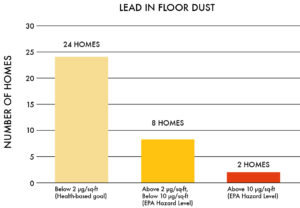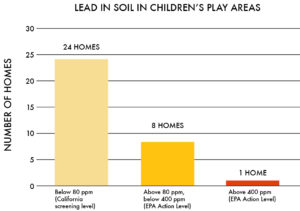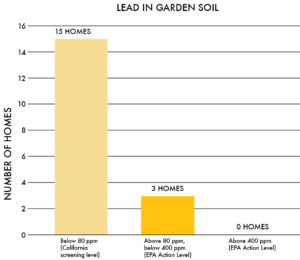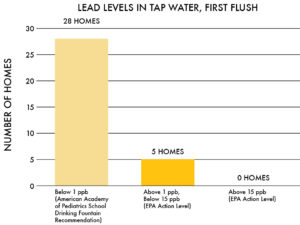Hidden Danger
Lead in Puget Sound Homes
Hidden Danger: Lead in Puget Sound Homes. Published 2019.
Many people are surprised to learn that lead poisoning is still a problem in the Puget Sound region. Although lead has been known for centuries as a toxic chemical, actions taken by companies in the 20th century have created lasting contamination of our homes and communities. To better understand the sources of exposure for the most vulnerable among us–our children–Toxic-Free Future worked with 34 families in testing their homes for lead.
Lead poses a risk to nearly every human body system, and health effects range from slowing children’s growth and development to learning and behavioral problems. Kids living in poverty and in older housing are more likely to have high levels of lead in their bodies. Because treatments for existing lead poisoning are limited, prevention is the most important way to stop health problems caused by lead. The first step is understanding the sources of exposure to lead, the goal of our Hidden Danger: Lead in Puget Sound Homes study.
Sources of Lead in Homes
No level of lead exposure is safe, and kids can be harmed at levels lower than the federal government’s action levels. In analyzing the results of our study, we therefore compared the concentrations found in Puget Sound homes with federal action levels but also with screening levels set or recommended by other states and organizations.
We found lead in a number of sources in Puget Sound region homes:
DUST. Lead was found in every sample of vacuum dust in the study. Floor dust samples from more than one quarter (29%) of households had concerning levels of lead, and levels in two homes were above federal standards. Local public health agencies have identified dust from lead paint as the biggest source of lead in homes, and our findings support this conclusion. Lead-based paint was widely used before its ban in 1978, so homes built before this date often contain lead-based paint.

SOIL. We also found lead in every soil sample tested. Lead in soil was at concerning levels in children’s play areas from more than a quarter of households (27%) and in garden soil in 17% of households.


WATER. We tested water samples at “first flush” (water immediately after turning on the tap), as well as water collected after the tap had run for 45 seconds (45-second flush) and 5 minutes (5-minute flush). All water samples met the federal action level. At first flush, 85% of samples also met the lower recommendation from the American Academy of Pediatrics for school drinking fountains. The level of lead went down when the water was running, and 94% met the recommended level after a 5 minute flush.

This list of sources is based on testing a small number of homes, and not all homes were tested in the same way under the study design. While more testing is needed to better pinpoint sources of lead, the results clearly show that lead continues to contaminate homes in the Puget Sound region.
A Lead-Free Future
This study’s findings support what many researchers and public health leaders have said: children continue to be exposed to lead from a number of sources within their own homes. While lead exposure decreased with the ban of lead in products like lead and gasoline, we need more action to prevent lead’s harmful effects. Washington State has begun this work with a Lead Chemical Action Plan by the Department of Ecology and a directive from Governor Inslee urging action to reduce kids’ exposure. Little follow-through with the recommended actions has occurred, however, so local groups have begun organizing. Toxic-Free Future has joined Public Health Seattle & King County and several community-based organizations to raise awareness of lead exposure in historically underserved communities and to develop community-driven responses to decrease lead exposure.
The lack of protective policies in the past has resulted in widespread contamination of our indoor and outdoor environments with this poison. We can’t undo this mistake, but future policies can prevent more children from suffering exposures to lead that can harm their ability to learn and thrive.
We urge the following governmental action:
- All children should have their blood lead levels tested. It’s important to identify high lead levels early in order to minimize harm and prevent further exposure. Local governments and state government should require that all children be tested.
- State and local governments should require landlords to inspect rental housing for lead. The Washington State Department of Health estimates that nearly 150,000 rental units currently contain lead hazards. Requiring landlords to inspect rental housing for lead would protect renters from exposure to lead in their homes.
- State and local governments should give financial assistance for home repairs to reduce lead exposure. A fee on paint or litigation against paint companies responsible for manufacturing and distributing lead-based paint could fund this program.
- Ongoing community education is needed to help families learn how to minimize their children’s lead exposure. Simple measures like those listed below can go a long way in preventing lead exposure.
Protecting Your Family from Lead
Here are a few simple steps that can help protect children from lead:
- Make sure kids do not have access to areas with peeling or chipping lead-based paint. As long as lead is well contained in the paint (no peeling or chipping areas where lead can escape), risks of exposure are much less.
- Wet mop floors and wet wipe window sills to reduce exposure to dust with lead.
- Wash children’s hands and toys frequently. This minimizes potential exposure from hand-to-mouth.
- Take shoes off at the door so that lead from outdoors is not tracked indoors.
- Where children play, cover soil with grass, bark, or wood chips. Young children can also play in a sandbox.
- Let the tap run until cold. After water has sat in pipes for a long time, run the tap before using water for drinking or cooking.
